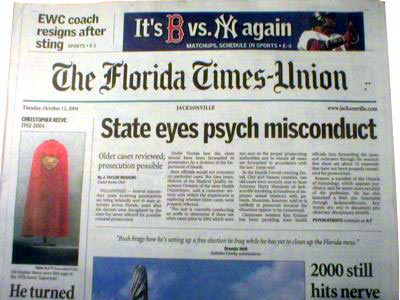Catch My Drift Pheromones: Our own personal love potion?

Copyright ©2002 Florida Times Union.
Dr. Winnifred Cutler's pheromone research and Athena Pheromone 10:13tm for Women featured in Florida Times Union Newspaper in Lifestyle section.
Excerpted by Athena InstituteReview the 2002 independent study on Athena Pheromone 10:13tm for Women, published in Physiology and Behavior click here
By Marcia Mattson
Love really is in the air -- at least around women who lace their perfume with human sex pheromones.
Researchers at San Francisco State University found that women dabbed with the enhanced perfume {Athena Pheromone 10:13tm} got more dates, physical affection and sexual activity than women scented with a placebo.
The study is the latest evidence that humans still emit and respond to pheromones -- odorless, colorless chemical mixtures known to guide behavior in animals and insects.
Pheromones cause instinctual behavioral responses in other members of a species.
Researcher Martha McClintock jump-started the human pheromone frenzy in 1971 when she observed that women who share a college dorm room eventually share synchronized menstrual cycles.
Since then, scientists debated whether humans have a working pheromone system. In 1986, Philadelphia researchers Winnifred Cutler and George Preti reported that both men and women seem to emit chemicals that regulate the female reproductive system.
They had a group of men and women wear underarm pads, then they swabbed the pads under other women's noses. Women who got a whiff of the female chemicals synchronized their menstrual cycles. Women swabbed with male chemicals developed more regular cycles.
In 1998, McClintock, now at the University of Chicago, found she could shorten or prolong women's cycles by swabbing their upper lip with perspiration from women in different stages of ovulation.
So it now seems clear: Sweat contains pheromones. And we are indeed unconsciously communicating, at least about sexual matters.
"I don't see any other conclusion," said Norma McCoy, one of the San Francisco State University researchers who studied the pheromone-enhanced perfume. "It was quite clear that these things worked."
Scientists already knew animals and insects communicate with pheromones. Rodents, for instance, rely heavily on the chemicals to choose their mates. Entomologists use pheromones to trap crop pests or confuse them so they can't find a mate.
But scientists used to think humans lost their super-sniffers as they evolved.
The human olfactory system looks different from other mammals. Our noses detect odors. But a separate olfactory pathway called the vomeronasal organ (VNO) is known to process pheromones in animals. Today's humans have a simple-looking VNO, leading some to think it's only a remnant of a non-functioning organ.
"As I understand it, the pheromones in question relate to the vomeronasal organ, which by many criteria no longer seem to operate in humans," said Ursula Goodenough, a researcher at Washington University. "This loss seems to have been co-evolutionary with the gain in the importance of visual and social cues in sexual choice in the primates."
But the modern human olfactory system may be more complex than scientists thought.
Various researchers in the last 10 years found tiny VNO openings, or nasal pits, in nearly all humans they studied; and discovered cells in an area called the olfactory epithelium that may process pheromones.
Cutler said the mechanism that triggers the change in behavior hasn't been determined, "but most likely the sex attractant pheromones of humans are mediated through the olfactory epithelium."
She thinks humans still produce pheromones (click for more on pheromone discovery) for sexual attraction, reproductive regulation, mother-infant recognition and territorial marking.
Historically, pheromones may have helped produce and maintain healthy human babies.
If the women in a group are fertile at the same short time, there's a greater chance more than one male in a group will be responsible for producing offspring. The result is a more diverse gene pool. And multiple women might be lactating at once, increasing the odds someone can feed an orphaned infant.
But what are the modern implications of a true "love potion"?
Socially, just ask anyone who can't get a date.
Financially, enormous.
Cutler left the University of Pennsylvania years ago to open the Athena Institute for Women's Wellness Research, which in the mid-1990s started selling chemical additives for men's aftershave and women's perfume (click for more product details).
She's now one of several manufacturers selling chemicals over the Internet that they claim attract the opposite sex. The San Francisco State University study used the product Cutler sells to women. {Athena Pheromone 10:13 for women}
"I have no idea what is being marketed," Goodenough said, "but I can't imagine any product being nearly as effective, in the mating area, as having an engaging appearance and being kind."
Or can it?
END OF EXCERPT
COMMENT FROM ATHENA INSTITUTE: Both Athena Pheromone 10:13tm for women and Athena Pheromone 10Xtm for men are cosmetics that can increase your attractiveness to the opposite sex. Neither product is an “aphrodisiac.”